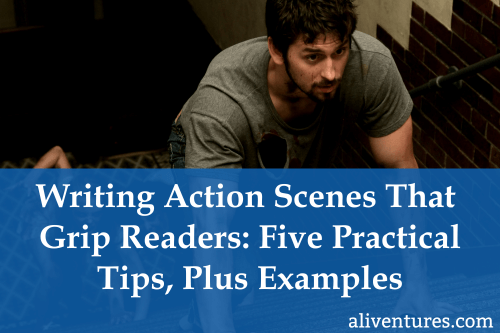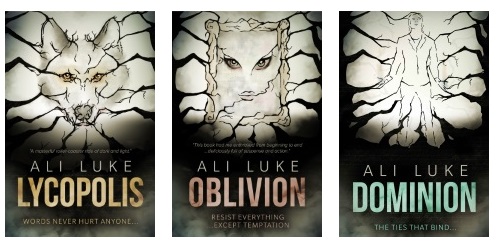Writing Action Scenes That Grip Readers: Five Practical Tips, Plus Examples

Are you struggling to write action scenes?
A lot of writers find it tricky to craft a scene that involves a lot of action. These might be crucial scenes in your plot – perhaps the turning point in the middle of your story, or the climax at the end – and you want them to grip the reader’s attention throughout. But juggling everything that needs to go into the scene can be tough.
Action scenes are often fight scenes or chase scenes … but they don’t have to be! Any scene that involves fast-moving action counts. Scenes with characters running for a train, or children playing in a playground, will need similar writing skills to more violent action scenes.
The main challenge of writing an action scene is making it exciting – without confusing or boring the reader along the way.
(You might think that non-stop action is inherently exciting and not at all boring, but blow-by-blow accounts of exactly what everyone is doing can soon become monotonous.)
Examples of Great Action Scenes (And Why They Work)
Before we dig into tips for writing your own action scenes, let’s take a look at some action scenes from published novels – and see why these work so well.
Example #1:The Hunger Games (Suzanne Collins)
A boy, I think from District 8, reaches [the backpack] at the same time I do and for a brief time we grapple for it and then he coughs, splattering my face with blood. I stagger back, repulsed by the warm, sticky spray. Then the boy slips to the ground. That’s when I see the knife in his back. Already other tributes have reached the Cornucopia and are spreading out to attack. Yes, the girl from District 2, ten yards away, running toward me, one hand clutching a half-dozen knives. I’ve seen her throw in training. She never misses. And I’m her next target.
All the general fear I’ve been feeling condenses into an immediate fear of this girl, this predator who might kill me in seconds. Adrenaline shoots through me and I sling the pack over one shoulder and run full-speed for the woods. I can hear the blade whistling toward me and reflectively hike the pack up to protect my head. The blade lodges in the pack. Both straps on my shoulders now, I make for the trees. Somehow I know the girl will not pursue me. That she’ll be drawn back into the Cornucopia before all the good stuff is gone. A grin crosses my face. Thanks for the knife, I think.
This action scene works well because it’s short! We have plenty of tension leading up to it – the tributes have to stand still for a full minute before the gong sounds and they’re able to run for the “Cornucopia” of goods that will help them survive in the arena of The Hunger Games. So when Katniss makes a move, she just grabs a backpack and then runs.
The short sentences help add to the tension, and I also like the sense of confusion: Katniss doesn’t know what’s happened at first when the boy in front of her coughs up blood, and it takes her a moment to realise he’s been hit by a girl throwing a knife – a girl who’s about to turn on her.
Example #2: The Shining (Stephen King)
“Well, I’ll fix you,” he said, and tried to put his hands around her throat.
She took a step backward, then another, and he stumbled against her. She remembered the knife in the pocket of her robe and groped for it, but now his left arm had swept around her, pinning her arm against her side. She could smell sharp gin and the sour odor of his sweat.
“Have to be punished,” he was grunting. “Chastised. Chastised . . . harshly.”
His right hand found her throat.
As her breath stopped, pure panic took over. His left hand joined his right and now the knife was free to her own hand, but she forgot about it. Both of her hands came up and began to yank helplessly at his larger, stronger ones.
“Mommy!” Danny shrieked from somewhere. “Daddy, stop! You’re hurting Mommyl” He screamed piercingly, a high and crystal sound that she heard from far off.
Red flashes of light leaped in front of her eyes like ballet dancers. The room grew darker. She saw her son clamber up on the bar and throw himself at Jack’s shoulders. Suddenly one of the hands that had been crushing her throat was gone as Jack cuffed Danny away with a snarl. The boy fell back against the empty shelves and dropped to the floor, dazed. The hand was on her throat again. The red flashes began to turn black.
Danny was crying weakly. Her chest was burning. Jack was shouting into her face: “I’ll fix you! Goddam you, I’ll show you who is boss around here! I’ll show you–”
But all sounds were fading down a long dark corridor. Her struggles began to weaken. One of her hands fell away from his and dropped slowly until the arm was stretched out at right angles to her body, the hand dangling limply from the wrist like the hand of a drowning woman.
It touched a bottle – one of the straw-wrapped wine bottles that served as decorative candleholders.
By this point in The Shining, Jack’s descent into violent madness is complete: he attacks his wife (Wendy) and child (Danny), and this scene is full of tension. Wendy is smaller and weaker than Jack, and he’s armed with a knife. She’s desperately worried for five-year-old Danny, but also for Jack himself, who she realises is possessed by the Overlook Hotel.
We see the desperation of the scene (“pure panic”, “helplessly”) and how Wendy is close to passing out (“the red flashes began to turn black”). The action is all filtered through her perspective – and the dialogue breaks in, giving variety to the writing, so that it doesn’t become just an endless string of one-action-after-another.
Example #3: Wool (Hugh Howey)
“I want to go out. I want to go out. Iwantogoout.”
Holston arrived at the cafeteria in a sprint. His radio was still squawking, Deputy Marnes yelling something about Allison. Holston hadn’t even taken the time to respond, had just bolted up three flights of stairs towards the scene.
“What’s going on?” he asked. He swam through the crowd by the door and found his wife writhing on the cafeteria floor, held down by Connor and two other food staff employees. “Let her go!” He slapped their hands off his wife’s shins and was nearly rewarded by one of her boots to his chin. “Settle down,” he said. He reached for her wrists, which were twisting this way and that to get out the desperate grips of grown men. “Baby, what the hell is going on?”
“She was running for the airlock,” Connor said through grunts of exertion. Percy corralled her kicking feet, and Holston didn’t stop him. He saw now why three men were needed. He leaned close to Allison, making sure she saw him. Her eyes were wild, peeking through a curtain of dishevelled hair.
“Alison, baby, you’ve gotta settle down.”
“I want to go out. I want to go out.” Her voice had quietened, but the words kept tumbling out.
There’s a lot going on here that the reader doesn’t yet understand (why is wanting to go out such a problem), and the viewpoint character Holston is clearly caught off guard too. Dialogue is really well integrated with the action, helping to avoid it becoming monotonous, and adding urgency through short, sharp sentences.
Example #4: The Curious Incident of the Dog in the Night-Time (Mark Haddon)
I pulled the fork out of the dog and lifted him into my arms and hugged him. He was leaking blood from the fork-holes.
I like dogs. You always know what a dog is thinking. It has four moods. Happy, sad, cross, and concentrating. Also, dogs are faithful and they do not tell lies because they cannot talk.
I had been hugging the dog for 4 minutes when I heard screaming. I looked up and saw Mrs Shears running towards me from the patio. She was wearing pyjamas and a housecoat. Her toenails were painted bright pink and she had no shoes on.
She was shouting, “What in fuck’s name have you done to my dog?”
I do not like people shouting at me. It makes me scared that they are going to hit me or touch me and I do not know what is going to happen.
“Let go of the dog,” she shouted. “Let go of the fucking dog for Christ’s sake.”
I put the dog down on the lawn and moved back 2 meters.
She bent down. I thought she was going to pick the dog up herself, but she didn’t. Perhaps she noticed how much blood there was and didn’t want to get dirty. Instead, she started screaming again.
I put my hands over my ears and closed my eyes and rolled forward till I was hunched up with my forehead pressed onto the grass. The grass was wet and cold. It was nice.
This isn’t a dramatic fight or chase, but it’s still a scene that involves a lot of action. The narrator, 15-year old Christopher, who is autistic, has just discovered his neighbour’s dog, which has been killed with a garden fork. The actions are clear and precise – reflecting Christopher’s focus on details – and the dialogue is well-integrated with the action.
Tips for Writing Your Own Action Scenes
Whether you’re writing a fight, a chase, or just a scene which involves characters doing a lot, here are some things that usually make for good action scenes.
Tip #1: For Fast-Paced Action, Use Shorter Sentences
Not all action scenes are fast-paced … but many are. If your characters are in the middle of a fight, long, complex sentences will bog down the narrative.
Use shorter sentences – or even sentence fragments – to create a sense of urgency. Look at the difference in pace (and tension) between these:
Long Sentences
James ducked down behind a tree, hoping they couldn’t see him. His breath came in fast pants as he thought, oh God – what was he going to do?
Short Sentences
James ducked behind a tree. Hopefully, they couldn’t see him. His breath came in fast pants. Oh God. What was he going to do?
(In some cases, breathless run-on sentences can also work well for action scenes, showing your viewpoint character’s fear or confusion.)
Tip #2: Keep the Description Minimal
While you need to describe enough that readers can picture the scene, you don’t need to give lots of details. Adding too much description will slow the pace of your action scene, making it less tense.
Compare these:
Lots of Descriptive Details
Maeve sprinted down the street, past a chicken shop with a faded sign above it and a menu peeling away from the window. There were a few teenagers huddled together inside.
She ran past a newsagents’ too: the window was almost completely obscured by posters, including one for a funfair that had ended a month ago.
“You all right love?” someone called.
She didn’t stop, as an old plastic bag, caught up in the wind, blew across her path.
Minimal Descriptive Details
Maeve sprinted down the street, the faded shopfronts a blur.
“You all right, love?” someone called.
She didn’t stop. Couldn’t stop. Had to get away.
Tip #3: Make Character Movements Clear (But Don’t Go Over the Top)
One of my struggles with action scenes is keeping track of everyone! If there are several characters and they’re moving around, I sometimes end up with a lot of blow-by-blow descriptions of their movement.
It’s usually helpful for the reader to know if one of your characters is standing right next to another, or shouting across the room to them. But for smaller movements or actions, you don’t need to spell everything out.
Compare these:
Lots of Character Movements Depicted
Ben stood up and pushed his chair under the pub table. “How about we get another drink and talk it through?”
Annie nodded, but Max folded his arms and stood too. He walked around the table to stand next to Ben, leaning in close. “There’s nothing left to talk about.”
Leaning forward, Phoebe put her head in her hands. “God. Can’t you lads give it a rest?”
Fewer Character Movements Depicted
Ben stood. “How about we get another drink and talk it through?”
Annie nodded, but Max came over to lean in close to Ben. “There’s nothing left to talk about.”
“God.” Phoebe put her head in her hands. “Can’t you lads give it a rest?”
Tip #4: Include Thoughts and/or Dialogue
A relentless stream of actions might sound exciting, but it’s going to come across as overwhelming (or even monotonous) to the reader.
Include your POV character’s thoughts, have characters react to things, or break up the action with some dialogue. This makes it easier for your reader to take in what’s happening – and in many cases, it’s also more realistic. It can also help show the stakes or explain a character’s motivations.
Compare these:
No Dialogue or Character Thoughts
Sadie threw the first punch; Maxine blocked it, then swung a punch of her own. Sadie ducked, grabbed a chair, and swung it at Maxine, who dodged before kicking out at Sadie. Moving fast, Sadie grabbed Maxine’s leg, dragging her to the floor.
Dialogue Plus POV Character’s Thoughts
Sadie threw the first punch.
Maxine blocked it – “You bitch!” – then swung a punch of her own.
“This is all your fault!” Sadie screamed, ducking.
“Shut up!”
Sadie grabbed a chair, and swung it at Maxine. How dare she steal Sadie’s boyfriend?
Maxine dodged and kicked out – but not fast enough. Sadie grabbed her leg, dragging her to the floor.
Tip #5: Avoid Summarising Crucial Bits of the Action
While it might sometimes make sense to summarise part of an action scene, if not much is really happening, you don’t want to summarise an actual fight or a really dramatic moment.
Avoid “telling” in these moments – instead, show the action taking place.
Telling/Summarising the Action
Davy escaped the bullies at first, only for them to catch up when he thought he was almost safe on his own street. They taunted him, and one snatched his football out of his hands.
Showing the Action
Davy ran as fast as he could, breath coming in gasps. Had he lost them? He was almost home – just a little further! But as he turned onto his street, he glanced back.
The three of them were gaining on him, fast. “Hey, shrimp! Give us the ball!”
“Don’t,” Davy began, but one of them – the biggest – grabbed his football.
Action scenes can be tough to put together … but they may well be pivotal moments in your plot, propelling your story forward. If you’re struggling, just get your scene down on paper: it can be really rough in the first draft. Then, as you edit, try using the tips above to adjust the pacing and make the scene more gripping.
About

I’m Ali Luke, and I live in Leeds in the UK with my husband and two children.
Aliventures is where I help you master the art, craft and business of writing.
Start Here
If you're new, welcome! These posts are good ones to start with:
Can You Call Yourself a “Writer” if You’re Not Currently Writing?
The Three Stages of Editing (and Nine Handy Do-it-Yourself Tips)
My Novels

My contemporary fantasy trilogy is available from Amazon. The books follow on from one another, so read Lycopolis first.
You can buy them all from Amazon, or read them FREE in Kindle Unlimited.

0 Comments